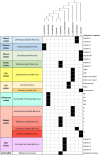Dissecting the Species-Specific Virome in Culicoides of Thrace
- PMID: 35330767
- PMCID: PMC8940260
- DOI: 10.3389/fmicb.2022.802577
Dissecting the Species-Specific Virome in Culicoides of Thrace
Abstract
Biting midges (Culicoides) are vectors of arboviruses of both veterinary and medical importance. The surge of emerging and reemerging vector-borne diseases and their expansion in geographical areas affected by climate change has increased the importance of understanding their capacity to contribute to novel and emerging infectious diseases. The study of Culicoides virome is the first step in the assessment of this potential. In this study, we analyzed the RNA virome of 10 Culicoides species within the geographical area of Thrace in the southeastern part of Europe, a crossing point between Asia and Europe and important path of various arboviruses, utilizing the Ion Torrent next-generation sequencing (NGS) platform and a custom bioinformatics pipeline based on TRINITY assembler and alignment algorithms. The analysis of the RNA virome of 10 Culicoides species resulted in the identification of the genomic signatures of 14 novel RNA viruses, including three fully assembled viruses and four segmented viruses with at least one segment fully assembled, most of which were significantly divergent from previously identified related viruses from the Solemoviridae, Phasmaviridae, Phenuiviridae, Reoviridae, Chuviridae, Partitiviridae, Orthomyxoviridae, Rhabdoviridae, and Flaviviridae families. Each Culicoides species carried a species-specific set of viruses, some of which are related to viruses from other insect vectors in the same area, contributing to the idea of a virus-carrier web within the ecosystem. The identified viruses not only expand our current knowledge on the virome of Culicoides but also set the basis of the genetic diversity of such viruses in the area of southeastern Europe. Furthermore, our study highlights that such metagenomic approaches should include as many species as possible of the local virus-carrier web that interact and share the virome of a geographical area.
Keywords: Culicoides; Greece; Thrace; arboviruses; emerging infectious diseases; metagenomics; vectors; virome analysis.
Copyright © 2022 Konstantinidis, Bampali, de Courcy Williams, Dovrolis, Gatzidou, Papazilakis, Nearchou, Veletza and Karakasiliotis.
Conflict of interest statement
PP was employed by the company Evrofarma S.A. AN was employed by the company Geotechno Ygeionomiki O.E. The remaining authors declare that the research was conducted in the absence of any commercial or financial relationships that could be construed as a potential conflict of interest.
Figures







Similar articles
-
Characterisation of the virome of Culicoides brevitarsis Kieffer (Diptera: Ceratopogonidae), a vector of bluetongue virus in Australia.J Gen Virol. 2025 Feb;106(2):002076. doi: 10.1099/jgv.0.002076. J Gen Virol. 2025. PMID: 39976626 Free PMC article.
-
Investigation of RNA Viruses in Culicoides Latreille, 1809 (Diptera: Ceratopogonidae) in a Mining Complex in the Southeastern Region of the Brazilian Amazon.Viruses. 2024 Nov 29;16(12):1862. doi: 10.3390/v16121862. Viruses. 2024. PMID: 39772171 Free PMC article.
-
Meta-Viromic Sequencing Reveals Virome Characteristics of Mosquitoes and Culicoides on Zhoushan Island, China.Microbiol Spectr. 2023 Feb 14;11(1):e0268822. doi: 10.1128/spectrum.02688-22. Epub 2023 Jan 18. Microbiol Spectr. 2023. PMID: 36651764 Free PMC article.
-
The virome of vector mosquitoes.Curr Opin Virol. 2021 Aug;49:7-12. doi: 10.1016/j.coviro.2021.04.002. Epub 2021 May 12. Curr Opin Virol. 2021. PMID: 33991759 Review.
-
Management of North American Culicoides Biting Midges: Current Knowledge and Research Needs.Vector Borne Zoonotic Dis. 2015 Jun;15(6):374-84. doi: 10.1089/vbz.2014.1705. Vector Borne Zoonotic Dis. 2015. PMID: 26086558 Review.
Cited by
-
Characterisation of the virome of Culicoides brevitarsis Kieffer (Diptera: Ceratopogonidae), a vector of bluetongue virus in Australia.J Gen Virol. 2025 Feb;106(2):002076. doi: 10.1099/jgv.0.002076. J Gen Virol. 2025. PMID: 39976626 Free PMC article.
-
Investigation of RNA Viruses in Culicoides Latreille, 1809 (Diptera: Ceratopogonidae) in a Mining Complex in the Southeastern Region of the Brazilian Amazon.Viruses. 2024 Nov 29;16(12):1862. doi: 10.3390/v16121862. Viruses. 2024. PMID: 39772171 Free PMC article.
-
RNA Virus Discovery Sheds Light on the Virome of a Major Vineyard Pest, the European Grapevine Moth (Lobesia botrana).Viruses. 2025 Jan 13;17(1):95. doi: 10.3390/v17010095. Viruses. 2025. PMID: 39861884 Free PMC article.
-
Meta-Viromic Sequencing Reveals Virome Characteristics of Mosquitoes and Culicoides on Zhoushan Island, China.Microbiol Spectr. 2023 Feb 14;11(1):e0268822. doi: 10.1128/spectrum.02688-22. Epub 2023 Jan 18. Microbiol Spectr. 2023. PMID: 36651764 Free PMC article.
-
Mitochondrial genome sequencing, mapping, and assembly benchmarking for Culicoides species (Diptera: Ceratopogonidae).BMC Genomics. 2022 Aug 13;23(1):584. doi: 10.1186/s12864-022-08743-x. BMC Genomics. 2022. PMID: 35962326 Free PMC article.
References
LinkOut - more resources
Full Text Sources

